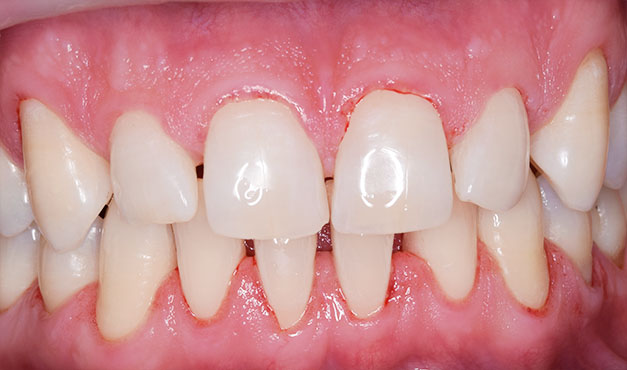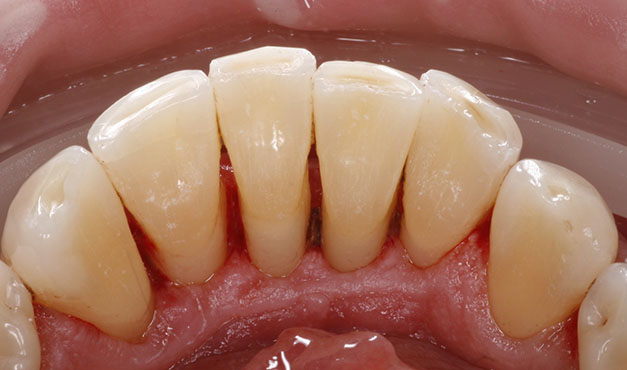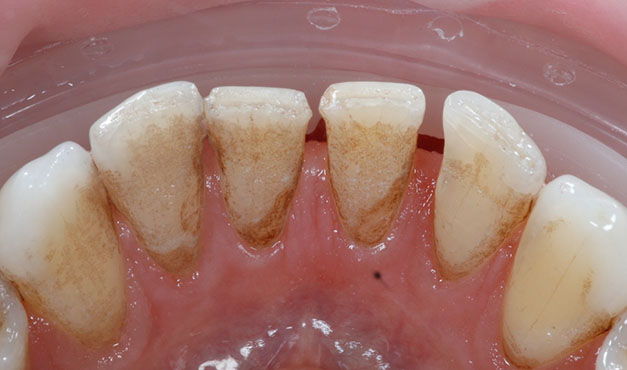Irányított biofilm terápia

Irányított biofilm terápia – a ma alkalmazható legmodernebb fogkőeltávolítási és fogtisztítási eljárás

Az Irányított Biofilm Terápia (angol rövidített néven GBT – Guided Biofilm Therapy) új dimenziót nyit a dentálhigiéniában. Erre mondják azt, hogy „game-changer”.
Az irányított biofilm terápia az egyéni betegdiagnosztikából és a kockázatértékelésen alapuló kezelési protokollokból áll, az optimális eredmények elérése érdekében.
Kiemelt jellemzője, hogy minimálisan invazív, gyengéd és biztonságos szájhigiéniai kezelést tesz lehetővé, mindezt fájdalommentesen. A kezelés kidolgozott, és hatékonyságában bizonyított 8 lépéses protokoll szerint történik, mely minden esetben egyéni betegdiagnosztikával és személyre szabott kockázatértékeléssel kezdődik, hangsúlyt helyez a megelőzésre és a személyes motiváció kialakítására, alapvető célként megjelölve a fogak, a fogakat körülölelő szövetek és a fogíny egészséges állapotának hosszútávú fenntartását.
Kedvezményes ajánlataink


Mi az a biofilm és miért szükséges eltávolítani?
A biofilm egy a fogak, fogíny, fogpótlások felületén kialakuló egybefüggő baktérium-közösség, amely egyaránt beborítja a fogakat, a fogínyt, a fogpótlásokat, beleértve még az implantátumot is. Ez a biofilm nem feltétlenül válik szabad szemmel láthatóvá, ettől függetlenül képes gyulladást okozni. Biofilm nem csak a fogakon található meg, hanem pl. az emésztőrendszer egészében is.
Jellemzője, hogy a biofilmet alkotó sejtek együttműködnek, összetömörödnek, ezzel nehezebben pusztíthatóak el, sokkal ellenállóbbak a hagyományos kezelésekkel szemben. A gyógyszerek is nehezen képesek behatolni a biofilmbe.
Azért fontos gondoskodni az eltávolításáról, mert (ahogy az indikációs területeknél is írjuk alább) fogszuvasodást, fogíny-, fogágygyulladást okozhat, továbbá akár potenciálisan az implantátum elvesztéséhez vezető fertőzések kialakulásához is hozzájárul. Ezen túlmenően bizonyított, hogy növelheti más betegségek kockázatát is (pl. szív- és érrendszeri megbetegedések, cukorbetegség, ízületi gyulladások).
Az irányított biofilm terápia 8 lépéses protokollja

- Állapotfelmérés, diagnózis – A kezelés első lépéseként a fogak, fogpótlások, az íny, a szájnyálkahártya teljes vizsgálata, az esetleges problémák feltárása, szükséges kezelések megállapítása történik.
- A biofilm rétegek felfedése plakkfestéses technikával – A problémás részek könnyebb láthatósága érdekében a fogakat és a fog körüli területeket plakkfestő anyaggal megszínezzük. Ez által a páciens is jobban láthatja azokat a részeket amik kezelésre szorulnak.
- Instuálás-motiválás, fogmosás oktatás – A plakk és a fogkő keletkezése – mely ínygyulladáshoz és ínytasakok kialakulásához vezethet – sokszor a helytelen fogmosásra vezethető vissza. A plakkfestés következtében láthatóvá válnak azok a területek, ahol a fogmosási technika vélhetőleg nem teljesen megfelelő. Fogorvosaink és dentálhigiénikusaink a 3. lépésben mindenkit személyes tanácsokkal látnak el a megfelelő szájápolással kapcsolatban és bemutatják a fogtisztító eszközök szabályos használatát.
- Biofilm, az elszíneződések, avagy a „fiatal” fogkő eltávolítása homokfúvással – Ebben a lépésben az elszíneződéseket távolítjuk el egy finom por segítségével. (#1 Airflow™)
- Az airflow poros kezelés második szakaszaként (szükség szerint) az íny alatt keletkezett tasakok kerülnek kitisztításra. (#2 Perioflow™)
- A teljes tisztítás befejező részeként a homokfúvással nem kezelhető, fennmaradt fogkő ultrahangos eltávolítása történik. (#3 Piezon™)
- Ellenőrzés – A tisztítás 3 szakaszának elvégzése után újabb állapotfelmérés történik, mely során a fogkő-elszíneződés által rejtett, lehetséges szuvasodások kerülnek feltárásra.
- Visszahívás – Az egészséges, szép fogak és íny fenntartásához fogszakorvosaink és dentálhigiénikusaink elengedhetetlennek tartják a rendszeres kontroll vizsgálatot, melyre pácienseinket esettől függően 2-3-6 illetve 12 hónapos időszakonként visszahívunk.
Árak












